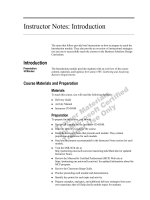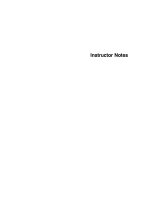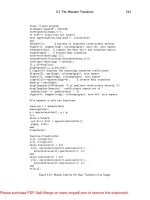Tài liệu Instructor Notes: Introduction doc
Bạn đang xem bản rút gọn của tài liệu. Xem và tải ngay bản đầy đủ của tài liệu tại đây (159.92 KB, 16 trang )
Instructor Notes: Introduction
The notes that follow provide brief instructions on how to prepare to teach the
Introduction module. They also provide an overview of instructional strategies
you can use to successfully teach the courses in the Business Solutions Design
Curriculum.
Introduction
The Introduction module provides students with an overview of the course
content, materials, and logistics for Course 1585: Gathering and Analyzing
Business Requirements.
Course Materials and Preparation
Materials
To teach this course, you will need the following materials:
!
Delivery Guide
!
Activity Manual
!
Instructor CD-ROM
Preparation
To prepare for this course, you should:
!
Review all contents on the Instructor CD-ROM.
!
Read the Delivery Guide for the course.
!
Read the Instructor Notes that precede each module. They contain
preparation suggestions for each module.
!
Read any documents recommended in the Instructor Notes section for each
module.
!
Visit the MIK Web site at
for updated
Instructor Notes.
!
Review the Microsoft
®
Certified Professional (MCP) Web site at
for updated information about the
MCP program.
!
Review the Classroom Setup Guide.
!
Practice presenting each module and demonstration.
!
Identify key points for each topic and activity.
!
Prepare examples, analogies, and additional delivery strategies from your
own experience that will help clarify module topics for students.
Presentation:
30 Minutes
2 Instructor Notes: Introduction
!
Review each activity. Anticipate the questions that students might ask.
!
Identify how each activity supports module topics and reinforces module
objectives.
!
Identify information that students need to complete each activity
successfully.
!
Note any problems that might arise during an activity and determine
strategies for resolving these problems in the classroom.
!
Identify additional preparation required to ensure the success of each
activity.
!
Identify ways to customize an activity to provide a more meaningful
learning experience for your specific audience.
!
Familiarize yourself with the Microsoft Online Evaluation System to gather
feedback from students. Start by reading information at
Instructor Notes: Introduction 3
Module Strategies
Use the following strategies to present this module:
!
Course 1585: Gathering and Analyzing Business Requirements
Show the slide that displays the course number and course title.
!
Introductions
Welcome students to the course and introduce yourself. Provide a brief
overview of your background to establish credibility.
Have students introduce themselves and provide their backgrounds, product
experiences, and course expectations.
Record student expectations on a whiteboard or flip chart that you can
reference later in class.
!
Course Materials
Explain the purpose of all materials used in this course.
Tell students that they will have an opportunity at the end of class to provide
feedback on the course and facilities by using the Microsoft Online
Evaluation System.
!
Prerequisites
Provide students with a list of prerequisites that they should have met before
taking this course. This is an opportunity for you to identify students who
may not have the appropriate background or experience to attend this
course.
!
MCP Program
Inform students about the MCP program and various certification options.
!
Facilities
Explain facility information for the training site.
4 Instructor Notes: Introduction
Instructor Notes for the Business Solutions Design
Curriculum
This section provides a brief overview of strategies you can use to successfully
teach the courses in the Business Solutions Design Curriculum. It is divided
into two parts. The first part suggests strategies for teaching the course content.
The second part suggests strategies for conducting the course activities.
Delivering the Course Content
You will find the courses in the Business Solutions Design Curriculum similar
to other Microsoft Official Curriculum (MOC) courses you have taught.
Prepare for them as you would other courses. The following are three additional
items to consider when delivering these courses.
Exam 70-100: Analyzing Requirements and Defining
Solution Architectures
The four courses that make up the Business Solutions Design Curriculum help
students prepare for Microsoft Certified Solution Developer (MCSD) Exam 70-
100. In addition, most students will need at least two years of professional
experience to pass the exam.
Students that attend the curriculum courses will most likely be a mix of those
preparing for Exam 70-100 and those attending the courses as part of their own
professional development. Keep the needs of both audiences in mind as you
teach the courses, but focus on teaching the objectives in each module and the
overall course objectives.
Using the Course Maps
A course map is a graphical representation of the content of a course. These
graphics help students visualize the structure of the course material and
determine where they are in the course as they proceed through each module.
The courses in the Business Solutions Design Curriculum include two types of
course maps:
!
Module-detail course maps
Starting with Module 2, at the beginning of each module is a map of the
entire course with the current module and its sections called out. Use this
graphic, the summary of the module on the Overview slide, and the
objectives of the module to prepare students for the material they are about
to learn.
!
Overall course maps
The Looking Forward slide in each module includes a course map that
reinforces which module students have just completed and which one they
will begin next. Use this graphic and the supporting student notes to link the
content of the current module to the content in the next module.
In Module 1, the overall course map appears next to the Overview of the
Course slide.
Instructor Notes: Introduction 5
Using the Review Section
Starting with Module 2, each module contains a Review section consisting of a
Guidelines slide, a Review Questions slide, and a Looking Forward slide.
The Guidelines slide includes suggestions on how to implement the module’s
concepts and skills in the workplace. This slide provides an opportunity to
relate the module content to real-life applications. You can present examples
from your professional experience to supplement this slide.
The Review Questions slide reinforces the content of the module by providing
students with an opportunity to reflect on the material. The questions also
address the module objectives that are knowledge oriented, rather than skill
oriented. Examples include objectives that ask students to list, describe, or
explain concepts and facts. When you ask the questions, give students a chance
to answer them for themselves before selecting someone to give an answer out
loud to the class.
You can ask additional questions as well. Use this slide to determine whether
any concepts need to be reviewed before you move on to the next module.
The Looking Forward slide is the final slide in the Review section and the
module. This slide helps you to link the current module to the next module, as
well as to additional content later in the course. The slide helps students to put
the current module in context with the rest of the course and relate all the
concepts and skills in the course.
Activities in the Business Solutions Design Curriculum
Unlike many MOC courses you may have taught, the courses in the Business
Solutions Design Curriculum do not have hands-on, computer-based activities.
Instead, the courses in the Business Solutions Design Curriculum contain
activities that involve class discussions and individual and small group pencil
and paper-based exercises.
Because the activities in Course 1585 involve developing materials that lead to
a first draft of a vision document, computers are optional. As the instructor, you
can decide whether students can use computers before delivering the course.
The activities in the Activity Manual do not indicate whether computers can be
used to complete the activities. You can set expectations for computer use
during the introduction to the course. Courses 1608 and 1609 do not require
computers to complete the activities.
Activity Solutions
Where applicable, each course provides a set of solutions for the activities in a
module. Solution files for each module are found on the Student CD.
Facilitating Group Activities
Many of the activities in each course involve small groups. The following list
offers suggestions for working with small groups successfully:
!
Choosing groups
You can decide whether to use the same small groups for the entire course
or have students regularly form new groups. If you are teaching the course
in a traditional computer lab, it may be difficult for students to regularly
change seats.
6 Instructor Notes: Introduction
You should take into consideration the different skills that each student
brings to the class. You may want to match up students with different skills
so that they complement and teach each other during the activities.
You may want to avoid changing groups in modules that have multiple
activities. Regularly changing groups in these modules can cause confusion
and loss of class time.
!
Timing
Keep track of time during each activity. Announce the amount of time
students have at the beginning of each activity. Encourage students to track
the number of tasks they must complete against the amount of time they
have remaining in the activity.
If students finish an activity early, complete the activity and begin
processing the results. If you let students wander around or start discussions
that are off the course subject, they can lose focus on the course material.
!
Processing group results
In large classes, having every group present all of its results in each activity
takes time from the other course content and activities and may not be
necessary. You may lose students’ interest if processing each activity takes
a long time. Instead:
• You can have one group present its results in detail. Then ask the other
groups to present only those results that differ from the main group.
• You can have the groups present one example each from their results.
• You can have the groups summarize their results on flip-chart paper.
Then the groups can quickly read each other’s results, and you can
summarize the results and ask for comments from the groups.
Make sure that students understand what the correct solution is for each
activity. There may be several correct solutions. At the end of each activity,
students should know how it should be done correctly. If necessary, you can
point them to the solutions folder for the appropriate module.
If the groups will use the results of an activity in subsequent activities, make
sure you verify that each group successfully completed the activity.
Optional Review Activities
This delivery guide contains four optional review activities that you can use at
the end and beginning of each day. The review activities provide a structured
process to help students reflect on the course material, and they can indicate
course concepts that you need to review before beginning new instruction each
day.
These activities also help provide a structured review of information. One of the
advantages of using these activities for review is that students are able to gauge
their own progress and take ownership of understanding the information.
Additionally, the activities provide a good measuring tool for determining the
current strengths and weaknesses of each student throughout the course.
The review activities are not referenced in the student workbooks or Activity
Manual. You determine whether they will work with your particular style of
course delivery. If you have not used this particular type of activity before, try it
once during a course to see if it you want to add them to your delivery skills.









